Haunted House Sound Effects: Crafting Eerie Experiences
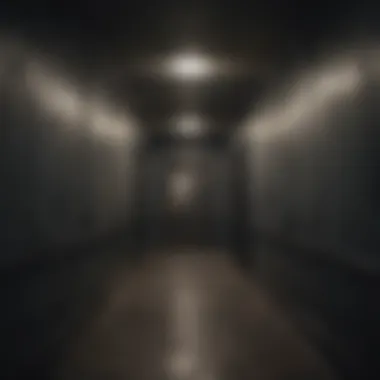
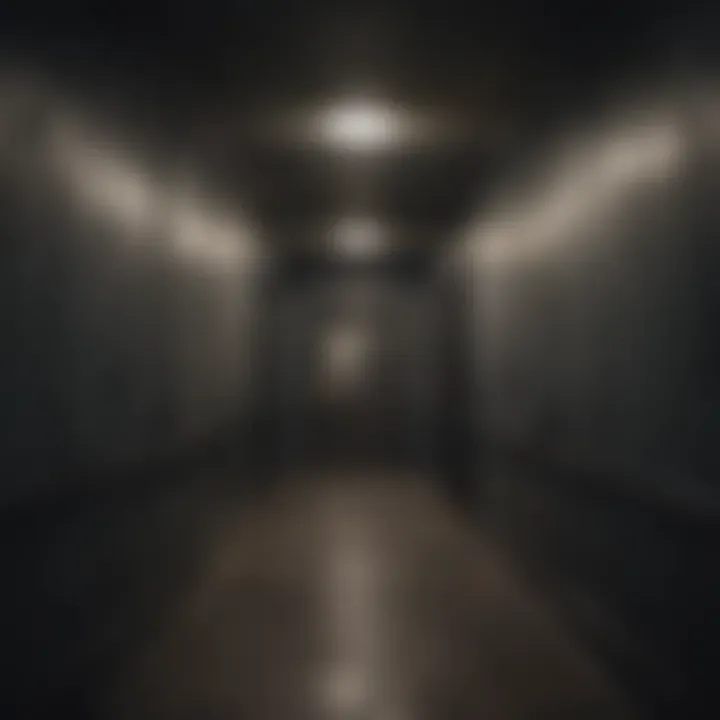
Intro
The world of sound effects in haunted houses is a rich and diverse landscape. It plays a significant role in how audiences experience fear, suspense and thrill. A well-designed auditory environment has the power to elevate the overall atmosphere. Understanding this dimension is key for sound designers, filmmakers, and enthusiasts alike.
Haunted house sound effects are not merely random noises. Each sound is carefully crafted and selected to evoke certain emotions. Sounds like creaking doors, distant screams, and ghostly whispers create a sense of unease. This article will explore the various elements that make these effects essential in shaping haunted experiences.
Artist Profile
Biography and Background
The field of sound design has evolved dramatically. Many notable figures have contributed to this art form. Pioneers in the industry include Walter Murch, known for his innovative work in film. His methods have influenced generations of sound designers. While not all professionals have such fame, each brings a unique perspective to sound collage.
Major Influences and Inspirations
Many sound designers draw inspiration from different genres and media. Classic horror films serve as a reference point. Movies such as "Psycho" and "The Exorcist" showcased how effective sound can be. Contemporary haunted attractions also borrow elements from video games and interactive media. They strive to create immersive environments that keep audiences engaged.
The Role of Sound Effects
Sound effects in haunted houses serve several purposes:
- Immersion: They help transport visitors into a different world.
- Emotional Trigger: Sounds can evoke strong feelings, from fear to nostalgia.
- Storytelling: Each sound contributes to a broader narrative, enhancing the theme.
"Sound is the invisible art that is an essential component of our emotional landscape." - Anonymous
Technical Aspects of Sound Design
Understanding the technical side is crucial for creating effective sound effects. Different tools and software are used. Programs like Pro Tools and Adobe Audition are industry standards. They allow designers to manipulate audio in complex ways.
Recording techniques also play a vital role. Field recordings capture authentic ambience. Effects such as reverb and delay are added during post-production to create depth.
Psychological Impact
The psychological effects of sound cannot be overstated. Certain sounds trigger primal instincts. For example, low-frequency rumbles can induce anxiety. High-pitched noises often lead to a sense of alertness. These reactions are rooted in human biology and evolution.
Understanding these aspects informs how sound is applied in haunted houses. Creators tailor soundscapes to maximize impact on the audience. Hence, the right auditory cues encourage engagement and participation.
Ending
The intricacies of haunted house sound effects merit deeper exploration. They combine historical context with modern technological advances. A comprehensive understanding benefits not only the creators but also the audience. Through sound design, the art of auditory storytelling thrives, enriching experiences across various media.
Foreword to Haunted House Sound Effects
The creation of haunted house sound effects is a critical component of the overall immersive experience in horror-themed attractions and events. Sound is more than just a background element; it influences mood, evokes emotions, and enhances storytelling. Specially designed sound effects can transport visitors into a world that feels frighteningly real.
Understanding the significance of these effects involves recognizing their psychological impact. Skilled sound designers tailor auditory experiences that can evoke fear, curiosity, or suspense. This can be achieved through the use of unexpected sounds, spatial audio techniques, and emotional cues embedded in the sound design. The interplay of sound with silence also plays a substantial role, creating tension and anticipation among the audience.
Moreover, the integration of diverse auditory elements—from eerie whispers to sudden crashes—helps in building a narrative that captivates attendees. The effectiveness of haunted house sound effects also lies in their ability to communicate a sense of place. For instance, the creaking of old floorboards or distant thunder can immediately situate a visitor in an unsettling environment, enhancing their overall experience.
As we explore this topic throughout the article, several key aspects will be elaborated upon. We will delve into the definitions and historical context of sound usage in haunting, explore different types of sound effects used, and examine the techniques in sound creation utilized by artists in this field. The psychological effects of these sounds, their application in film and gaming, and recent innovations will also be discussed. This comprehensive guide aims to illuminate the intricacies and artistry involved in designing haunted house sound effects.
Defining Haunted House Sound Effects
Understanding haunted house sound effects requires an examination of how these auditory elements contribute to the overall experience of fear and immersion. At its core, haunted house sound design creates a specific atmosphere that evokes emotional responses from participants. Through a well-crafted selection of sounds, designers can manipulate the audience's feelings, making them more susceptible to the intended thrill.
Importance of Sound Effects in Haunted Houses
Sound effects play a fundamental role in setting the stage for a haunted house. Without the right auditory cues, the visual elements may fall flat. Sound effects encapsulate the psychological aspects of fear, creating tension and anticipation. Elements like creaking doors or distant screams can trigger primal instincts, heightening the experience of horror. In essence, sound enhances realism; it fills space in ways that visuals alone cannot.
Factors to consider while defining haunted house sound effects include:
- Contextual Relevance: Sound effects need to align with the themes present in the attraction. Whether it is a Victorian haunted mansion or a zombie apocalypse, the sound should blend seamlessly with the narrative.
- Pacing and Timing: The timing of sound effects can significantly affect their impact. A sudden loud noise at the right moment can startle visitors, creating a memorable scare.
- Layering Sounds: Often, effects are not standalone. Layering different sounds, such as background ambience mixed with sudden loud noises, can create a more complex auditory experience.
"The fusion of visual and auditory elements creates a holistic experience that immerses the audience in a realm of fear."
Benefits of Defining Haunted House Sound Effects
Defining these sound effects thoroughly brings various benefits. Firstly, it aids in creating cohesive and compelling experiences across different haunted attractions. Consistency in sound helps establish an identity. Secondly, sound effects can serve as low-cost enhancements to attractions, maximizing engagement without extensive investment in set designs. Finally, sound in conjunction with lighting and set design can facilitate the immersion process, leading to an emotionally charged atmosphere.
Historical Context of Sound in Haunting
The relationship between sound and haunting experiences has evolved greatly over time. Understanding this historical context provides a foundation for appreciating how sound contributes to fear and immersion in haunted settings. Various cultural and psychological elements have informed the way sound is used in terrifying environments. From ancient folklore to contemporary haunted houses, sound effects have played a central role in setting the mood and initiating emotional responses.
Early Uses of Sound in Haunted Experiences
In ancient times, sound was often associated with the supernatural. Cultures used drumming, chanting, and isolation to evoke fear and wonder. Such practices were integrated into rituals that aimed to connect with spirits or ward off malevolent forces.
These early uses of sound were typically rudimentary but carried significant meaning. For instance, a loud drumbeat could represent the heartbeat of the earth, fostering a sense of connection with the spirits. Moreover, folklore from various cultures often featured specific sounds as harbingers of doom. Examples include the howling winds associated with the arrival of ghosts or eerie silence preceding a supernatural event. This context captures the essence of how early humans perceived sound as a vital element in their understanding of the ethereal realm.
As haunted experiences gained popularity, theatrical performances began to incorporate sound design. Early plays utilized live music and sound effects to enhance narratives of horror. The presence of sound was crucial in engaging audience extrasensory perceptions.
Evolution of Sound Design Techniques
The evolution of sound techniques has transformed haunted experiences significantly. Early sound methods were largely manual, relying on physical props and performers to generate effects. The advent of technologies brought new possibilities, profoundly altering how sound was created and manipulated.
As theater evolved, so did the approach to sound design. The introduction of electrical devices changed everything. In the 20th century, with the rise of cinema and radio, sound design gained a more prominent role in storytelling. By combining both sound effects and music, creators began to craft intricate auditory experiences to invoke terror.
Recording technology made it possible to capture real-life sounds. This breakthrough allowed sound designers to integrate authentic environmental noises into their work. For instance, using creaky floorboards or distant thunder enhanced immersion, creating a more believable haunting atmosphere.
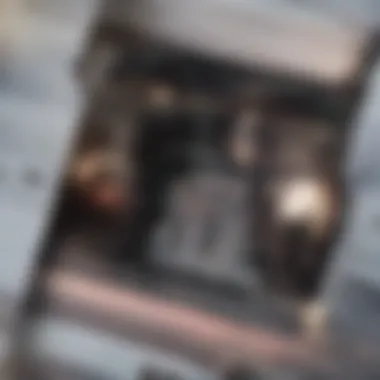
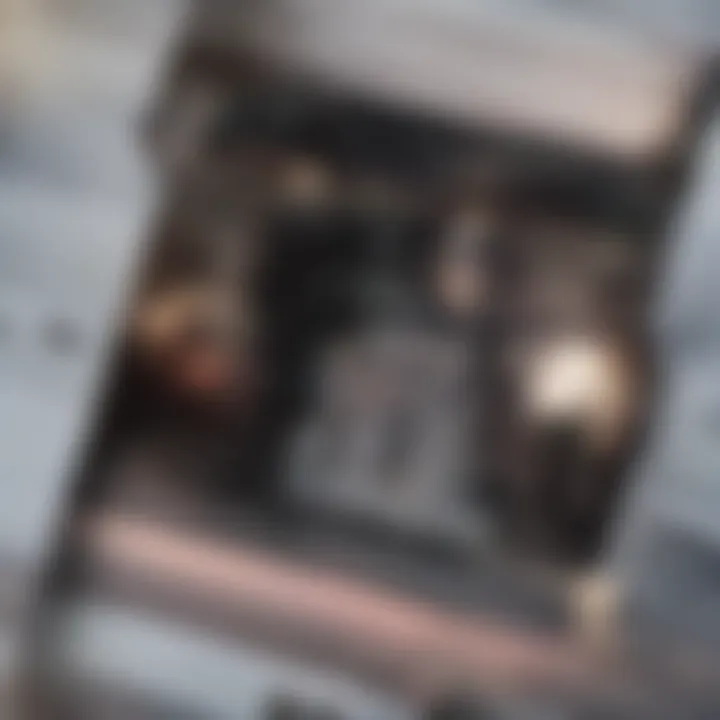
With advancements in digital technology, sound design has become increasingly sophisticated. Modern haunted attractions now utilize complex systems for creating interactive soundscapes. Techniques like 3D audio and surround sound produce a richer, more engaging experience.
Additionally, software allows for manipulation of audio in real-time, enabling soundscapes to change dynamically based on audience interaction. This capability ensures that each visit to a haunted house offers a unique auditory experience, further enriching the emotional impact.
"The evolution of sound design techniques shows how technological advances can significantly enhance the compelling nature of haunted experiences."
Understanding the historical context of sound in haunting experiences allows us to appreciate the depth and complexity involved in the art of sound design. As we continue to explore this fascinating topic, it becomes clear that these intricate audio elements are essential for invoking fear and crafting memorable experiences.
Types of Haunted House Sound Effects
The realm of haunted house sound effects encompasses a broad spectrum of auditory elements that play an essential role in shaping user experiences. Understanding the different types of sound effects is imperative for creators aiming to elicit specific emotions from their audience. Each sound contributes to an atmosphere that evokes tension, fear, or intrigue. By thoughtfully integrating various sound elements, designers can craft enveloping experiences that transport individuals into otherworldly settings.
Ambient Sounds
Ambient sounds serve as the foundation of the auditory experience in haunted attractions. They provide a constant backdrop that immerses visitors into the scenario. Typical ambient sounds can include rustling leaves, distant thunder, or the soft hum of wind. These sounds help set the stage and evoke a certain mood. A calm ambient sound may create anticipation, while ominous tones can suggest danger.
These layers are crucial for maintaining a narrative continuity that engages the audience. For instance, a subtly eerie sound can evoke awareness of an unseen presence. This technique keeps individuals alert and enhances their suspense.
Monstrous Growls and Screams
Monstrous growls and screams are integral to creating moments of shock and fear. Such harsh, guttural noises shock listeners and disrupt the ambient tranquility. These sound effects can indicate danger lurking nearby, heightening the sense of urgency. When designed effectively, screams can trigger an immediate emotional reaction, compelling the audience to confront their fears.
Moreover, the characteristics of these sounds can vary widely. Designers often experiment with pitch and resonance to craft unique auditory experiences. For instance, a low rumbling growl might suggest a formidable foe, while high-pitched shrieks may evoke panic. The variations provide auditory clues that enhance the storytelling aspect of the attraction.
Whispers and Echoes
Whispers and echoes add a layer of intimacy and mystery to haunted house soundscapes. Subtle whispers can suggest the presence of spirits, guiding or misleading visitors. This creates a psychological effect that heightens tension. Visitors often find themselves straining to hear, which draws them deeper into the experience.
Echoes serve a similar purpose. They can imply vast, abandoned spaces, adding depth to the environment. An echoing voice can reflect isolation or lost souls searching for connection. Using these sound types strategically allows creators to manipulate audience perceptions and feelings toward the environment.
Creaks and Groans of the Environment
Creaks and groans are universal symbols of unease. These sounds can represent age, decay, or instability, evoking thoughts of danger. For example, the creaking of floorboards or the groaning of doors can make visitors feel vulnerable. These sounds build anticipation for what might happen next.
Furthermore, incorporating environmental sounds can create realism. The audience perceives a more authentic experience when they hear creaks associated with a dilapidated structure. This attention to detail can significantly enhance immersion and engagement. By ensuring these sounds are interspersed throughout the visitor experience, sound designers reinforce the haunted atmosphere, stimulating both fear and fascination.
Techniques in Creating Sound Effects
Creating effective sound effects is critically important in both haunted attractions and multimedia applications. The techniques employed in sound creation can heighten emotional responses, enhance audience immersion, and ultimately define the experience. Proper sound effects are not just enhancements; they are integral components that can make or break the overall impact of the attraction or scene.
Various techniques exist for producing these haunting sounds. Each offers unique benefits and considerations that can influence the end results. Understanding these methods provides insight into how sound shapes our encounters with horror and suspense.
Field Recording Techniques
Field recording is the practice of capturing real-world sounds in their natural environments. This technique is vital for creating authentic soundscapes that resonate with audiences.
- Recording Equipment: Using high-quality microphones, audio interfaces, and portable recorders is fundamental. Each device offers different capabilities, such as directionality and sensitivity, which influence the final sound quality.
- Locations: Choosing unique and eerie settings for recordings can build a diverse sound library. Each location provides its sounds, like rustling leaves, distant howls, or creaking doors, which contribute to the desired atmosphere.
- Techniques of Capturing: Experimenting with microphone placement and recording techniques, such as stereo and binaural recording, can create depth and spatial awareness. The positioning in relation to the source can drastically alter the sound, adding layers and textures.
Field recordings also foster a unique connection between the sound designer and the environment. This interaction often leads to unexpected discoveries that can enhance creativity and originality in sound effects.
Digital Manipulation and Synthesis
Digital manipulation and synthesis involve altering recorded sounds or generating new ones with software. These methods allow for greater flexibility and creativity in sound design.
- Sound Editing Software: Programs like Pro Tools, Ableton Live, and Adobe Audition enable sound designers to alter pitch, speed, and dynamics. These alterations allow for the creation of otherworldly sounds that do not exist in nature.
- Sound Libraries: There are vast libraries of pre-recorded sounds available that can be modified. These sounds can be layered, manipulated, or even combined to create new effects.
- Synthesis Techniques: Synthesis refers to creating sound by generating waves. Using synths like Serum or Massive can produce synthetic sounds, from subtle ambient tones to terrifying growls. Designers can manipulate various parameters to achieve desired haunting qualities.
Digital manipulation allows for precision in sound crafting. However, balancing digital techniques with authentic recordings can yield richer results. Using these methods creatively can lead to unique auditory experiences that resonate deeply with audiences.
"The artistry of sound design lies not only in what is heard but in what is felt. Each sound string interlaces to tell a story that colors the shadowed realms of our imagination."
Mastering these techniques equips sound designers with the tools necessary to shape fear, evoke emotions, and craft memorable experiences in both haunted house attractions and other media.
Psychological Effects of Haunted Sounds
The psychological effects of haunted sounds are crucial to understanding their role in immersive experiences. Sound is a powerful medium that influences human emotions and perceptions. In haunted settings, sound effects are not mere background noise; they stimulate reactions that can heighten fear, anxiety, or intrigue. This is particularly important for designers and creators who aim to elicit strong emotional responses from their audience.
By examining this topic, we can discern how sound design can manipulate feelings and build atmospheres that draw individuals deeper into a narrative or environment. Sound can evoke memories or suggest danger, functioning subconsciously to impact a person's mental state.
Fear Induction through Sound
Fear is often the primary objective in haunted houses, films, and games. Designers leverage sound to short-circuit normal emotional responses and induce feelings of terror. There are several elements effective for fear induction.
- Volume and Pitch: Sudden loud noises or high-pitched sounds can trigger an immediate fight-or-flight response. This is why screams, crashes, or even whispers can jolt the audience.
- Dissonance: Jarring sounds or dissonant combinations disrupt the calm atmosphere. These sounds create unease and surprise, common tools in horror design.
- Silence: Strategic silence can create tension. When sounds suddenly cut out, anticipation builds, and the audience is left wondering what might come next.
- Repetition: Repeating certain sounds, such as creaking doors or distant moans, reinforces their significance, making them haunting reminders of fear.
These methods reveal how sound can effectively shape the audience's state. Through a blend of these techniques, a well-crafted audio experience can seep into one’s subconscious, transforming their perception of safety into one of apprehension.
Emotional Response to Auditory Cues
The emotional response elicited by auditory cues is profoundly significant in haunted settings. Sound experiences can be complex and layered, capable of invoking a wide array of feelings beyond fear.
- Nostalgia: Certain sounds may trigger childhood memories related to fear, making the experience personal. For instance, the sound of a creaking floor can remind someone of stories told in their youth, reinforcing a sense of nostalgia while simultaneously causing fear.
- Discomfort: Noises like dripping water or wind howling can cause discomfort and create feelings of isolation. This discomfort can pertain to relatable human fears of being alone or cold, making the experience visceral.
- Surprise and Shock: Unexpected audio, such as a sudden loud noise or a shift in sound dynamics, can elicit shock. This visceral reaction contributes to forming a deeper memory of the encounter.
Sound Design in Film and Gaming
Sound design is a crucial aspect of film and gaming, particularly when it comes to creating an immersive atmosphere. In the context of haunted experiences, sound can elicit strong emotional responses. Unlike visuals, sound often works subtly, shaping mood and tension without overt distraction. This makes it a powerful tool in the arsenal of creators seeking to enhance storytelling.
Using sound strategically can heighten anxiety or anticipation. Such a dynamic quality allows sound to interact with the visuals more deeply. This synergy is key to producing an engaging experience. Creators must consider how sound complements visuals, as mismatched elements may confuse or disengage the audience.
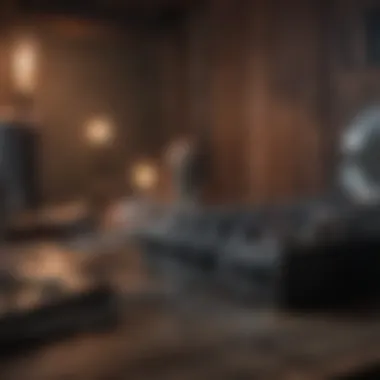
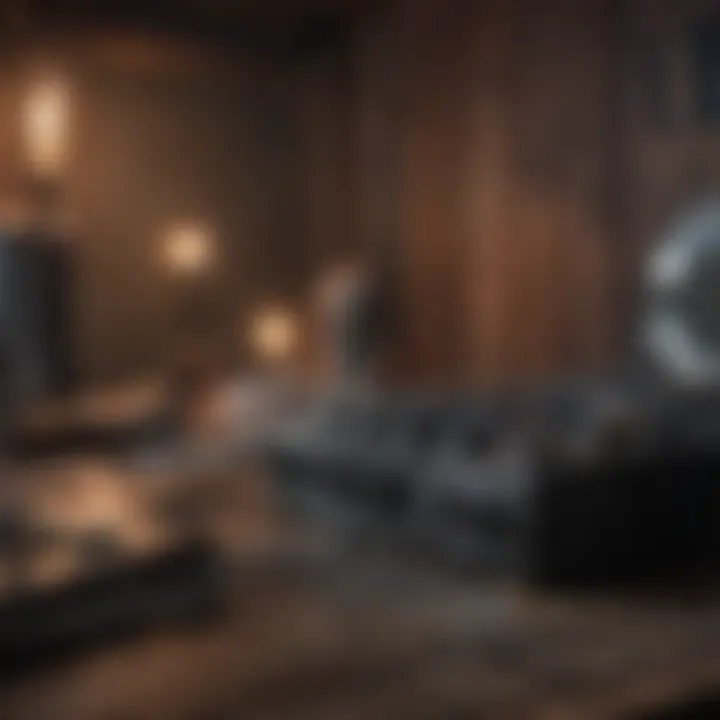
Moreover, effective sound design requires a profound understanding of human psychology. For instance, certain frequencies, like low bass, can invoke feelings of discomfort or fear. This knowledge informs the crafting of soundscapes that align with intended emotional impacts.
"Sound is often the silent partner that influences audience perception and emotion in storytelling."
Integration into Film Scenarios
In film, sound is intricately woven into the narrative structure. A well-designed soundscape does more than support the plot; it can indicate shifts in tone or foreshadow events. Think of the classic horror films where a sudden thunderclap immediately precedes a shocking revelation. This timing amplifies surprise and escalates tension.
In horror films, layers of sound effect are essential. Ambient sounds build the atmosphere, while sudden, jarring noises can deliver shock value.
Some core aspects of sound integration in films include:
- Diegetic Sound: Sound that both the characters and audience can hear, like creaking doors or whispered threats.
- Non-Diegetic Sound: Sound that only the audience hears, such as emotive music during a suspenseful scene.
- Sound Design Techniques: Techniques such as foley, where sound effects are created in sync with the visual, add realism and enhance the overall effect.
By focusing on these techniques, filmmakers establish a rich audio-visual experience that resonates with viewers long after the film ends.
Immersive Gaming Soundscapes
Gaming represents an interactive platform where sound design plays a pivotal role. Players navigate environments that need to feel alive. Immersive soundscapes achieve this by integrating sounds that respond to player actions. For example, hearing footsteps behind in a horror game elevates the sense of urgency.
Key elements that contribute to immersive soundscapes in gaming include:
- 3D Audio: Utilizing spatial audio technology ensures players perceive sounds from specific directions, enhancing realism.
- Dynamic Soundtrack: Adaptive music changes with player progress, adjusting intensity to momentum in-game.
- Environmental Cues: Sounds like rain, wind, or distant howls can convey location, weather, and mood.
These audio cues are more than mere enhancements; they are, in many ways, the foundation of gameplay experience. The success of many horror games lies in how effectively they use sound to create unsettling environments that provoke player fear and excitement.
Innovations in Haunted House Sound Effects
The realm of haunted house sound effects has continually evolved, shaping the experiences offered to audiences. Innovations in this field lay a critical groundwork for enhancing immersion and emotional engagement. This section will explore unique elements and benefits associated with these advancements, highlighting their potential to redefine how sound is perceived in haunted attractions.
Use of 3D Audio Technology
3D audio technology plays a pivotal role in transforming the auditory landscape of haunted houses. Unlike standard stereo sound, which presents audio from two channels, 3D audio creates a realistic spatial experience. By simulating how humans naturally perceive sound, this technology allows for sounds to seem as if they are coming from specific locations in the environment.
- Directional Cues: Audiences can distinguish where sounds originate, whether from above, behind, or beside. This adds layers of terror as unexpected noises can jolt a person unexpectedly.
- Depth and Distance: Sounds can be manipulated to create a sense of distance. For instance, a distant growl can terrify guests as it approaches, heightening their anxiety.
- Realism: The immersion factor increases. Participants feel as if they are genuinely surrounded by the haunting, making the experience memorable.
"The use of 3D audio technology transforms the listener's environment completely, making them a part of the haunting narrative."
Interactive Sound Experiences
With advances in technology, the integration of interactive sound experiences has emerged as a significant trend in haunted attractions. This involves engaging guests through sounds that react in real-time to their actions or choices.
- Triggered Audio Events: For example, when a visitor steps on a specific area, eerie sounds can be unleashed, creating an unpredictable environment. Each step can heighten the excitement and dread.
- Personalized Experiences: Sounds can be tailored to individual paths taken by participants. This dynamic interaction enhances the personal engagement with the story of the haunted house.
- Gamification Elements: Integrating sound with game-like features adds an additional layer of enjoyment. Visitors may find themselves immersed in unique auditory encounters that can change from one visit to the next.
The embrace of these innovations in haunted house sound effects demonstrates a shift toward more immersive, emotionally gripping experiences. As technologies continue to develop, the future promises even more sophisticated auditory engagement strategies.
Case Studies of Effective Sound Use
The significance of case studies in sound effects used in haunted houses cannot be underestimated. These real-world examples provide invaluable insights into how sound enhances the immersive experiences that haunt attractions aim to deliver. By analyzing renowned haunted attractions and notable horror films, readers can grasp the practical applications of sound design and the impactful role the various elements play in generating fear, anxiety, or suspense. Additionally, these case studies highlight both the artistry and technology behind creating effective soundscapes.
Renowned Haunted Attractions
Some renowned haunted attractions serve as prime examples of effective sound use. One such attraction is the Haunted Mansion at Disneyland. Here, sound plays an integral role in setting an eerie yet whimsical atmosphere. Almost every room is filled with atmospheric ambient sounds, from the distant murmurs of ghosts to the echoing footsteps that guests cannot see.
Another meticulous example is Universal Studios’ Halloween Horror Nights, which employs strategic sound design to enhance the experience. Each maze features unique auditory cues that complement visual stimuli; for instance, specific sounds trigger fear responses just moments before encountering a performer.
The sound effects used in these attractions are not merely background noise. They actively engage the audience and manipulate emotional responses. Sounds can create surprises or precede scares, building a cohesive narrative that transports the visitor into a different realm.
Famous Horror Films
Examining sound use in famous horror films further illustrates its impact in creating tension and fear. For instance, the film The Shining employs unsettling soundscapes that blend unsettling silence with abrupt auditory intrusions. The cacophony of bizarre noises, such as distant screams and sudden thuds, enhances the psychological horror of the narrative.
Another notable example is A Quiet Place, where silence becomes a powerful tool intertwined with sound effects. The contrast between moments of silence and sudden breathtaking sounds amplifies the tension tremendously. Audiences feel these shifts on a visceral level, leading to more heightened emotional reactions. By employing audio effectively, filmmakers craft suspense that captivates viewers, keeping them on edge throughout the film.
"Sound is the constant player in our psychological perceptions; it reinforces every element of horror, from the spectral to the mundane."
Both haunted attractions and films exemplify the versatility and power of sound. The thoughtful integration of various types of sound effects tip the balance in favor of truly immersive and frightening experiences. Recognizing these strategies allows creators in both industries to enrich their projects and keep audiences engaged.
The Future of Sound Effects in Haunting
The evolution of sound effects in haunted attractions is not merely a technical endeavor; it's also a cultural one. As audiences become more discerning, the auditory experiences in haunted settings need to adapt and innovate continually. Focusing on the future of sound effects allows us to explore emerging technologies and trends that can enhance audience engagement. This section outlines how new tools and approaches can redefine the auditory landscape of haunted environments.
Emerging Technologies
Technology is rapidly changing the landscape of sound design in haunted houses. Virtual reality (VR) and augmented reality (AR) have introduced new possibilities. These tools allow for more immersive experiences where sound interacts with visual elements. For example, a ghost might whisper as it appears, creating a seamless audio-visual experience that draws the audience's senses.
Spatial audio is another significant advancement. This technology allows sound to be positioned in a three-dimensional space, offering a realistic auditory environment. Imagine a scenario where footsteps seem to come from behind, making participants turn around in fright. The manipulation of sound positioning can evoke stronger reactions and increase the terror factor.
Moreover, advancements in artificial intelligence (AI) can personalize experiences. AI algorithms can analyze visitors’ reactions and adjust sound effects accordingly. If a visitor appears startled, sounds can be amplified or altered, making each visit unique. This level of interactivity adds depth and dimension to haunted experiences, positioning sound effects at the forefront of audience engagement strategies.
Trends in Audience Engagement
As technological tools evolve, so do the methods of engaging audiences in haunted attractions. Recently, there has been a noticeable shift toward interactivity. Visitors are not just passive observers; they are active participants. This engagement reshapes how sound can be used to immerse them further.
Auditory feedback is becoming crucial in creating tension. For instance, when a visitor triggers a specific event—like opening a door—sound reactions can enhance suspense. Using ambient sounds that shift in intensity based on the visitor’s movement creates a sense of being watched, even when alone.
Additionally, there is a trend to integrate psychological principles into sound design. Sounds are chosen not just for their quality but for their psychological impact. Specific frequencies and rhythms can induce anxiety or excitement, enhancing emotional reactions and making the experience memorable.
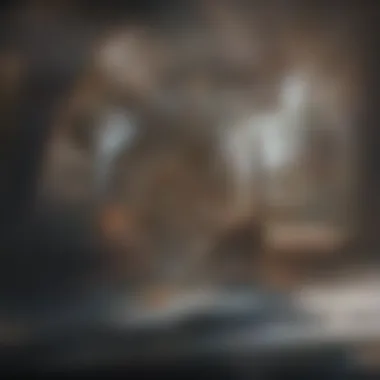
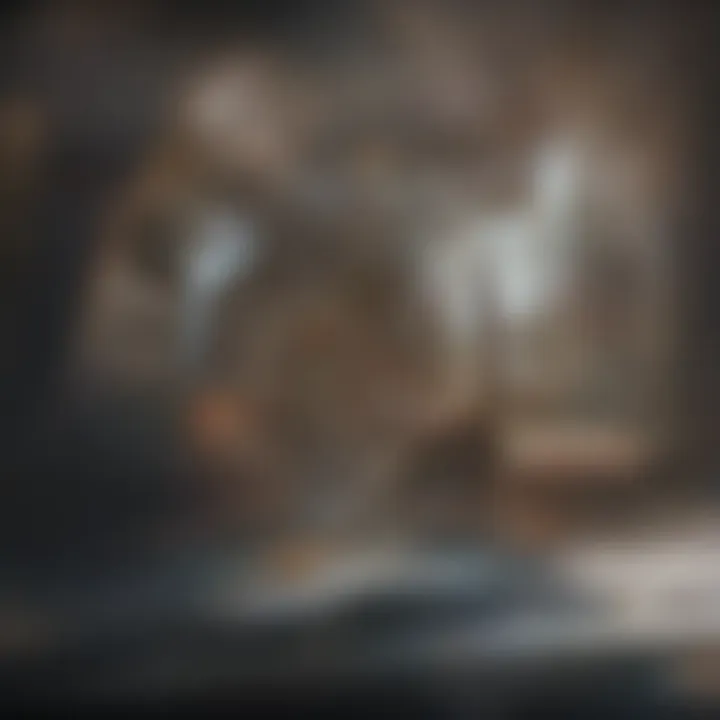
The future of sound effects in haunting is not just about shock; it's about creating deeply engaging experiences that resonate on multiple levels.
In summary, the future of sound effects in haunted houses is promising. Emerging technologies like VR, AR, and AI enable a more immersive environment tailored to audience reactions. Trends focused on interactivity and psychological engagement further enhance the experience. As these elements come together, they will redefine the standards for sound in haunted attractions, pushing the boundaries of what is possible.
Integration of Sound Across Media
The integration of sound across various media forms is crucial in crafting immersive experiences that engage audiences on multiple levels. In this context, the role of sound transcends its basic function, serving as a vehicle of mood, emotion, and narrative depth. Whether in haunted houses, films, or video games, sound reinforces the storytelling, creating a complete sensory experience that captivates individuals while exploring themes of fear and suspense.
One primary benefit of this integration lies in its ability to enhance believability within a narrative. Sound tracks and effects provide an emotional backdrop, guiding audience reactions. In a haunted attraction, for instance, the abruptness of a scream or the subtle background hum can evoke immediate anxiety or tension. It shapes the environment and solidifies the emotional responses that visual elements alone may not achieve.
Furthermore, the consistency of sound across different media is significant. Audiences have come to expect a certain quality and style of sound design, which can be transferred effectively from one form to another. This continuity allows creators to build a recognizable brand or feeling that resonates across diverse platforms, helping in audience retention and engagement.
In considering the technical aspects, sound designers must pay attention to how their work translates across different media. For example, spatial audio techniques utilized in games can create a more immersive experience than what is available through traditional film scoring. Using varying audio dynamics can influence how space is perceived and how users enter the narrative.
"The transformative power of sound design across media can dramatically shift audience perceptions and emotional responses, underscoring the art of horror storytelling."
Whether it's in haunted houses or digital platforms, sound serves as a connective tissue binding the audience to the experience. This integration is fundamental for creators to understand, as it determines how effectively they can engage their audience’s senses and evoke the intended emotions.
Soundtrack Contributions in Horror
Soundtracks play a vital role in horror cinema, creating a framework within which the story unfolds. The soundscape helps set the stage for fear, building tension through a carefully selected mix of ambient sounds, musical scores, and effects. A well-composed horror soundtrack becomes not just an accompaniment but an integral part of the narrative.
For instance, consider John Carpenter's iconic Halloween score. The simplicity of the piano melody layered with subtle synthesizers tells more of the story than dialogue ever could. Moreover, variations in tempo and instrument choices throughout a film can guide viewers’ emotional responses, enhancing suspense or excitement at critical moments.
Similarly, in haunted houses, the soundtrack is crucial for amplifying the immersive experience. Sounds of rustling leaves, distant screams, and eerie music work harmoniously to envelop visitors in an atmosphere of dread. The combination could lead to physiological reactions, triggering a fight or flight response as individuals navigate the spaces.
Cross-Media Influences
Cross-media influences illustrate how sound from one domain can enrich another. This interaction is particularly apparent in how horror films affect the sound landscapes of video games. Designers often borrow techniques and successes from films to create a similar fear response in gaming environments. The crossover allows for innovation and experimentation, resulting in highly engaging experiences.
Sound design in video games often takes inspiration from film techniques. For example, developers may use similar motifs or sound cues that have proven effective in horror films. This shared lexicon of sounds leads to recognizable auditory triggers that can elicit fear.
Moreover, live performances also adapt sound influences from different media, utilizing techniques from film and games. By doing so, the auditory experience becomes richer and stands out, allowing creators to draw from a broader palette.
Importance of Sound in Live Events
Sound plays a critical role in the execution of live events, especially within the realm of haunted attractions. Unlike static mediums like film or television, live events require an immediate auditory response that connects performers to the audience. This immediacy creates an immersive experience that is vital in haunting atmospheres.
Auditory Marketing in Haunted Attractions
In haunted attractions, auditory marketing is not just a concept but a necessity. Sound can entice visitors, drawing them into the haunting experience before they even step through the door. It helps set the tone.
- Sound cues can trigger emotions and expectations.
- Background noises can create an unsettling atmosphere, leading to heightened anticipation.
- Specific sound effects like screams, whispers, or eerie music can guide guests through the event, making it feel more alive.
Effective auditory marketing involves crafting soundscapes that complement the visual components of a haunted attraction. For example, combining distant thunder with a low hum of unsettling music can envelop the visitor in suspense. This technique generates curiosity while simultaneously evoking fear, ensuring visitors remain engaged throughout.
Live Sound Engineering Techniques
Live sound engineering is essential in the production of sound for haunted events. This process must ensure that sound is delivered in a crisp, clear manner while maintaining its haunting quality. Sound engineers must consider several factors:
- Acoustic Properties: The venue's architecture will influence how sound travels. Understanding these properties helps in attaining optimal sound balance.
- Technology Utilization: Mixing boards, microphones, and speakers need to be tailored to the event's requirements. For instance, directional speakers can focus sound in specific areas, enhancing immersion.
- Real-Time Adjustments: Engineers must be prepared to make on-the-fly corrections as live audiences can react unpredictably.
Those techniques are central not only to producing an effective sound but also to maintaining a cohesive experience across the event. When executed thoughtfully, sound design can transform a simple haunted house into a psychological labyrinth, captivating and terrifying audiences simultaneously.
"Sound is the invisible thread that stitches together the guest's experience."
With careful integration of sound in live events and strategic auditory marketing, haunted attractions can create a compelling ambiance that keeps audiences longing for more. The careful balance of technology and artistry allows sound to enhance the narrative, and when done well, evokes a memorable experience that extends beyond the event itself.
End
In this article, we closely examined the intricacies of haunted house sound effects. These auditory elements play an essential role in crafting memorable experiences for visitors and audiences alike. Sound effects evoke emotions, create an atmosphere, and enhance storytelling, making them crucial in various contexts, from haunted attractions to films and gaming.
The ability to sway emotions through sound cannot be overstated. We found that the human brain responds to auditory cues in ways that can induce fear, set mood, or evoke nostalgia. By understanding the psychological impact of sound, creators can effectively engage their audience's senses, making their experiences more immersive.
Key elements of sound effects include:
- Diverse Sound Types: Ambient sounds, monstrous growls, and whispers contribute to a fully realized soundscape. Each type has a unique role in shaping perceptions and reactions.
- Technological Advances: The integration of 3D audio and interactive experiences allows for deeper audience engagement. As technology evolves, so too does the potential for innovative sound design.
- Historical Context: Understanding the evolution of sound design techniques provides valuable insights into how contemporary sound effects have emerged and adapted societal preferences over time.
Furthermore, the merging of sound across different media highlights its versatility. The seamless transition of sound design concepts from live events to film showcases the interconnectedness of these elements. This adaptability makes sound a significant focus for future innovations in event planning and multimedia engagements.
References and Further Reading
Understanding haunted house sound effects requires more than just an appreciation for spooky noises. Comprehensive research and reading can provide valuable insights into the historical, psychological, and technical aspects discussed in this article.
Importance of References
References serve as the backbone of knowledge, especially in a field as nuanced as sound design. They not only clarify concepts but also offer additional layers of meaning that can enrich one's understanding. Engaging with well-researched articles, books, and studies allows sound designers and enthusiasts alike to discover methodologies and innovative techniques that have been used in various haunted attractions.
Key Benefits of Further Reading
- Expanded Knowledge: Delving into specialized literature on sound design can illuminate the intricate ways sound impacts emotional responses.
- Historical Context: Resources such as academic journals can provide a deeper historical context for the evolution of sound in haunted experiences.
- Technical Insights: Reading about technological advancements allows creators to stay updated with methods such as the use of 3D audio technology and digital manipulation.
Considerations for Effective Research
When seeking references, consider the following:
- Credibility of Sources: Opt for reputable publications and sites, such as en.wikipedia.org and britannica.com, to ensure that the information is valid.
- Diversity of Perspectives: Explore various viewpoints, which can add depth to your understanding of sound design.
- Engagement with Community: Platforms like reddit.com can facilitate discussions with other enthusiasts and professionals, fostering a richer learning environment.
Ending
In summary, the section on References and Further Reading highlights their crucial role in enhancing knowledge about haunted house sound effects. By engaging with diverse, credible sources, one can significantly improve their understanding and application of sound design principles within this fascinating domain.
"The right resources can transform a good sound designer into a great one."
To further explore sound design, consider reviewing content from trusted platforms and participating in discussions on forums such as facebook.com. These resources can expand your toolkit and inspire creativity in creating haunting auditory experiences.







